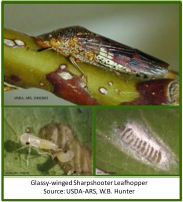Glassy-winged Sharpshooter Leafhopper (Homalodisca vitripennis)
 Glassy-winged sharpshooter Image source: |
Contact: Wayne Hunter, USDA-ARS
Researchers involved: 15 and growing
Size (or size of nearest relative): 15 and growing
Keywords (and why important): Vector of plant pathogens, Xylem feeder, pseudodiapause
The Glassy-winged sharpshooter, GWSS, (Homalodisca vitripennis) [Hemiptera: Cicadellidae], occurs naturally within the southern United States. Once restricted to the southeastern states, it was accidentally spread across the south into California. The GWSS is a voracious feeder, and can fly long distances, preferring to feed upon cultivated crops, ie. Grapevine, fruit trees, and in the nymphal stages many weeds and grasses.
The GWSS is a serious threat to the viticulture industry as the primary vector of the plant-infecting bacterium, Xylella fastidiosa, Xf. The GWSS feeds on a diverse number of plants, during which the bacteria can infect many tree fruit, nut, vine, and woody ornamental crops.
The Glassy-winged Sharpshooter adults are ½ inch (13mm) long being fairly large for the Sharpshooter leafhopper family of insects. Sharpshooters use an ovipositor to lay eggs inside of the underside of leaves. The Sharpshooter will lay its eggs on almost any plant including cactus. The egg masses are usually composed of 10-20 eggs, but can lay more or as few as 1. Most of the egg masses have a waxy coating of brocosomes around the eggs for protection. The nymphs (5 instars) do not have wings, but develop wing pads in the 5th instar and are generally smaller than the adults, ranging in size from .07 inches (2 mm) to nearly ½ inch (13mm) long. The nymphs have very distinct red eyes. The Sharpshooter can consume about 300 times its own weight in fluids from the xylem vessels of the plants upon which it feeds, thus producing copious amounts of excreta fluid.
Genomic Resources
For the most current version of the assembly, please use 'NCBI BioProject' (find link below). If the assembly is unavailable in the BioProject page (it is still being worked on), you can look under the 'BCM-HGSC data' (find link below) for intermediate versions of the assembly.
Web Apollo: A web-based sequence annotation editor for community annotation
For information about Web Apollo, please contact Monica Poelchau.
-
Web Apollo annotation tool (requires log in)
-
Web Apollo Jbrowse viewing of the automated annotation tracks (no log in required)
Additional Resources
Learn more about the glass-winged sharpshooter